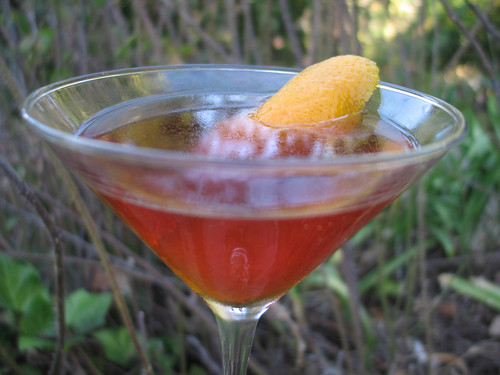Rob Roy
Base spirit, sweet vermouth and bitters. It’s a classic combo, which gave us the Martinez and the Manhattan to name but two (not to mention myriad Manhattan variations).
The Scotch whisky version of this combination has long deserved its own name (don’t call it a Scotch Manhattan!). Here’s the basic recipe.
Rob Roy
2 ounces blended Scotch whisky.
1 ounce sweet vermouth.
2 dashes Angostura bitters.Stir with ice for 30 seconds and strain into a chilled cocktail glass. Garnish with a cherry.
A Rob Roy lends itself very well to being made as a Perfect Rob Roy (1/2 ounce each of sweet and dry vermouth) or a Dry Rob Roy (1 ounce dry vermouth). If you make it dry garnish with a lemon peel; if perfect you may use either lemon peel or cherry.
Gary Regan is a proponent of Peychaud’s Bitters in a Rob Roy, and I’m very much with him on this. The cherry and anise flavors of Peychaud’s marry well with the peat and smoke of Scotch, and I’ve been making mine with Peychaud’s ever since I first read his suggestion. Like this — here’s what we’d probably hand you if you came over and asked for a Rob Roy:
Rob Roy
(Chuck & Wes’ typical version)2 ounces Famous Grouse 12-year-old blended Scotch whisky.
1 ounce Cinzano sweet vermouth.
2 dashes Peychaud’s bitters.
Lemon twist.Stir and strain, chilled cocktail glass, express oil from twist and garnish.
Gary goes further, though. He’s a major espouser of the “garbage-in-garbage-out” theory, and is even bold enough to advocate the use of powerfully flavored single malt Scotch whiskies in cocktails (something which causes a few Scotch-drinking acquaintances of mine to recoil in horror). I’m with Gary on this one, but it requires careful consideration of flavor and balance.
Brief digression: We’ve been watching a series on the Fine Living Network called “Great Cocktails.” When we heard about it we were intrigued but skeptical; I’ve seen plenty of bad TV about cocktails, and I was hoping this one would raise the bar. For the most part, it does. While we do disagree with some of the things espoused by the host (please don’t encourage home cocktail mixers to freepour — use a jigger!), generally the approach is very good, and they’re talking to all the right people, including Duggan McDonnell, Audrey Saunders and Gary.
On the last edition of “Great Cocktails” that we watched, Gary made a Rob Roy — a classic cocktail — yet remade it entirely by using one of the most powerful Scotch whiskies in existence. When using so powerful an ingredent, you need to adjust the balance of your drink so that the Scotch doesn’t completely overwhelm everything else. In this case the standard 2:1 (or occasional 3:1) ratio gets bumped up to equal proportions, with more bitters then you’d normally use.
It sounds mad, but trust me — it works. I made these the other night when Wes wasn’t feeling well. It wasn’t strictly medicinal, although it did have that effect. It was, in addition, a ballsy and stupendous drink.
The Laphroaig Rob Roy
(from the delightfully mad Gary Regan)1-1/2 ounces Laphroaig 10 Year Old Scotch Whisky.
1-1/2 ounces Cinzano Rosso vermouth.
4 healthy dashes Peychaud’s Bitters.Combine with ice in a mixing glass and stir for no less than 30 seconds. Strain into a chilled Champagne flute. I’d omit the garnish, unless 1) you’re really crazy, and 2) you had one of my friend Barry’s smoked cherries (he threw a pan of them into the smoker when we was smoking a hunk of meat; technique described here).
It cured him for a day, but then he got sick again yesterday. I should have made two.
[UPDATE: Not only is the Roy Roy a great cocktail, it’s also one of my very favorite bars anywhere. When in Seattle visit Rob Roy, have some of their great cocktails, and tell Zane and Anu that Chuck and Wes said hi!]






